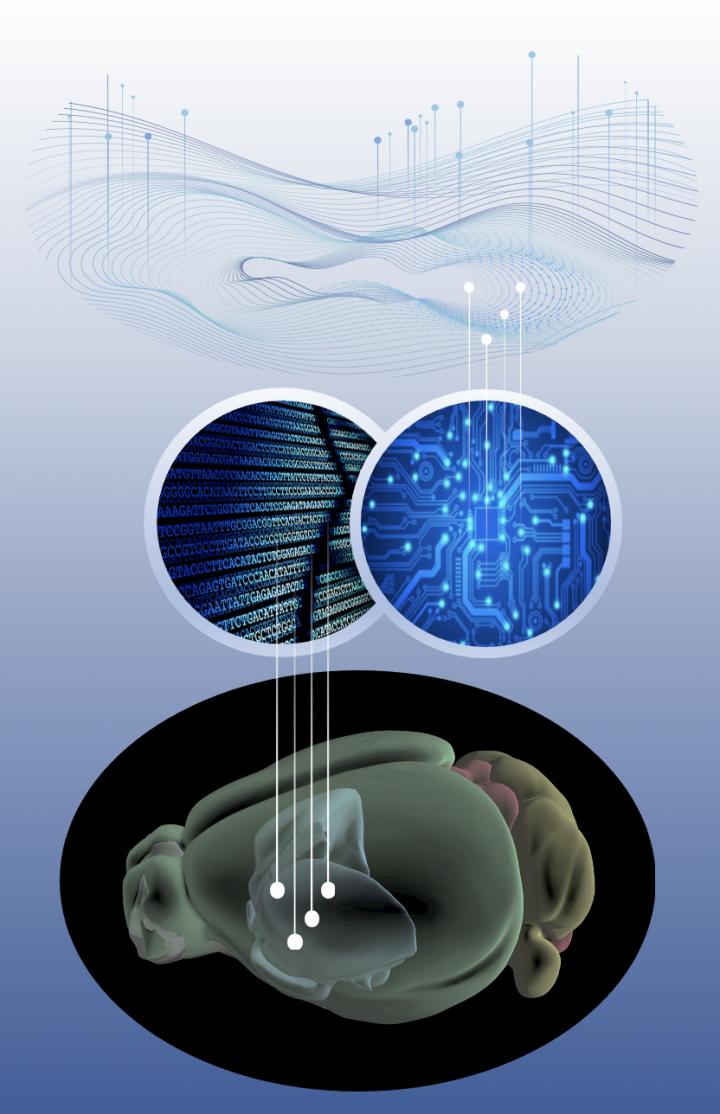
Credit: Sorbonne Université
Using an innovative computational approach to analyze vast brain cell gene expression datasets, researchers at MIT and Sorbonne Université have found that Huntington’s disease may progress to advanced stages more because of a degradation of the cells’ health maintenance systems than because of increased damage from the disease pathology itself.
The analysis yielded a trove of specific gene networks governing molecular pathways that disease researchers may now be able to target to better sustain brain cell health amid the devastating neurodegenerative disorder, said co-senior author Myriam Heiman, Associate Professor in MIT’s Department of Brain and Cognitive Sciences and an investigator at The Picower Institute for Learning and Memory. Christian Neri of the Sorbonne’s Centre National de la Recherche Scientifique is the co-senior and co-corresponding author of the study published in eLife.
“If we can maintain the expression of these compensatory mechanisms, it may be a more effective therapeutic strategy than just trying to affect one gene at a time,” said Heiman, who is also a member of the Broad Institute of MIT and Harvard.
In the study, the team led by co-corresponding author Lucile Megret created a process called “Geomic” to integrate two large sets of data from Heiman’s lab and one more from UCLA researcher William Yang. Each dataset highlighted different aspects of the disease, such as its effect on gene expression over time, how those effects varied by cell type, and the fate of those cells as gene expression varied.
Geomic created plots of the data that mapped differences pertaining to 4,300 genes along dimensions such as mouse age, the extent of Huntington’s-causing mutation, and cell type (certain neurons and astrocytes in a region of the brain called the striatum are especially vulnerable in Huntington’s). The plots took the form of geometric shapes, like crumpled pieces of paper, whose deformations could be computationally compared to identify genes whose expression changed most consequentially amid the disease. The researchers could then look into how abnormal expression of those genes could affect cellular health and function.
Big breakdowns
The Geomic analysis highlighted a clear pattern. Over time, the cells’ responses to the disease pathology–linked to toxic expansions in a protein called Huntingtin–largely continued intact, but certain highly vulnerable cells lost their ability to sustain gene expression needed for some basic systems that sustain cell health and function. These systems initially leapt into action to compensate for the disease but eventually lost steam.
One of the biggest such breakdowns in an especially vulnerable cell type, Drd-1 expressing neurons, was maintaining the health of energy-producing components called mitochondria. Last year, Heiman’s lab published a study in Neuron showing that in some Huntington’s-afflicted neurons, RNA leaks out of mitochondria provoking a misguided and immune response that leads to cell death. The new findings affirm a key role for mitochondrial integrity and implicate key genes such as Ndufb10 whose diminished expression may be undermine the cell’s network of genes supporting the system.
The Geomic approach also highlighted an especially dramatic decline in the Drd-1 neurons and in astrocytes of expression of multiple genes in pathways that govern endosome regulation, an essential process for determining where proteins go and when they are degraded within the cells. Here, too, key genes like Rab8b and Rab7 emerged as culprits within broader gene networks.
The researchers went on to validate some of their top findings by confirming that key alterations of gene expression were also present in post-mortem samples of brain tissue from human Huntington’s patients.
While mitochondrial integrity and endosome regulation are two particularly strong examples, Heiman said, the study lists many others. The Geomic source code and all the data and visualizations it yielded are publicly accessible on a website produced by the authors.
“We’ve created a database of future targets to probe,” Heiman said.
Neri added: “This database sets a precise basis for studying how to properly re-instate brain cell compensation in Huntington’s disease, and possibly in other neurodegenerative diseases that share common compensatory mechanisms with Huntington’s disease.”
Key among these could be regulators of genetic transcription in these affected pathways, Heiman said.
“One promising future direction is that among the genes that we implicate in these network effects, some of these are transcription factors,” she said. “They may be key targets to bring back the compensatory responses that decline.”
A new way to study disease
While the researchers first applied Geomic’s method of “shape deformation analysis” to Huntington’s disease, it will likely be of equal utility for studying any neurodegenerative disease like Alzheimer’s or Parkinson’s, or even other brain diseases, the authors said.
“This is a new approach to study systems level changes, rather than just focusing on a particular pathway or a particular gene,” said Heiman. “I think this is a really nice proof of principle and hopefully we can apply this type of methodology to the study of other genomic data from other disease studies.”
###
In addition to Heiman, Neri and Megret, the paper’s other authors are Barbara Gris, Satish Nair, Jasmin Cevost, Mary Wertz, Jeff Aaronson, Jim Rosinski, Thomas Vogt, and Hilary Wilkinson.
The Sorbonne Université, the CHDI Foundation and the National Institutes of Health supported the Research. Heiman’s lab is also supported by the JPB Foundation.
Media Contact
David Orenstein
[email protected]
Related Journal Article
http://dx.




